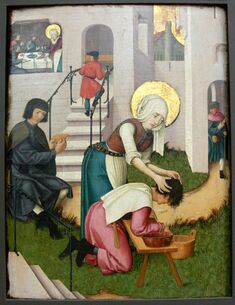ڤيرينا
| Saint Verena | |
|---|---|
 Late Gothic sculpture in Grödig parish church, Verena holding a jar (her conventional attribute) | |
| Hermit | |
| وُلِد | 3rd century Thebes, Egypt |
| توفي | 4th century Bad Zurzach, Switzerland |
مكرّم في | Roman Catholic Church Oriental Orthodox Churches[مطلوب توضيح] |
| Canonized | Pre-Congregation |
| الضريح الرئيسي | Bad Zurzach, Verena Gorge Hermitage |
| عيده |
|
| الصفات | comb; water jar |
| يرعى | poor; sick; lepers; young girls, nurses |
Saint Verena is an early Christian saint and hermit associated with the Theban Legion.
She is especially venerated in Switzerland, where her cult is attested in Bad Zurzach, the reported place of her burial, from at least the 5th century. She is recognized as a saint in the Roman Catholic Church as well as in the Eastern Orthodox Church and the Oriental Orthodox Churches.
الأسطورة

The oldest tradition of the life of Verena is found in the so-called Vita prior by Hatto, the abbot of Reichenau (and later bishop of Mainz), written in c. 888. The younger Vita posterior was most likely written by a monk in Zurzach in the 11th century, the oldest extant copy dating to the 12th century.
According to Hatto's account, Verena was born in Thebes as the daughter of a notable Christian family. She was educated by a bishop named Chaeremon (Vita prior, ch. 3). A bishop Chaeremon of Nilopolis is mentioned by Eusebius as martyred in 250, which would place Verena's birth before that date.
After the death of Chaeremon, Verena travelled to Lower Egypt with a group of Christians, where the Theban Legion was being recruited. With the Theban Legion, she then travelled to Milan (Vita prior ch. 4).
While still in Milan, she heard of the martyrdom of the Theban Legion (an event of uncertain historicity, traditionally dated to 286, during the reign of Maximian) and travelled to Agaunum (modern-day Saint-Maurice). In later sources, she is said to have buried the martyred legionnaires.
She then moved on to Salodurum (Solothurn) and joined a hermitage, and spent her days in fasting and prayer, and working miracles. Hatto presents her as a prototype of the consecrated virgin, telling that she attracted a following of young virgins. She was at one point imprisoned by a local governor, and Saint Maurice appeared to her in jail to console and strengthen her. After she was released from, she continued her good works. At the end of her natural days, she retired into a narrow cave.
The year of her death was calculated as 344 by Johannes Laurentius Huber (1812–1879), provost at Verenamünster in Zurzach.[2] If her birth before 250 is accepted (based on the identification of her mentor, bishop Chaeremon), this would imply that she was more than 95 years old at the time of her death.
المأثور
القديسة فيرينا قديسة قبطية كانت تصحب الكتيبة الطيبية بعض العذارى من القبطيات الذين كانوا يعدون الطعام ويقومون برعاية الجرحى وغير ذلك من الأعمال وكانت من بينها القديسة فيرينا التي نشأت في مدينة جراجوس بالقرب من مدينة طيبة (الأقصر) ويعنى اسم فرينا باللغة القبطية الثمرة أو البذرة الطيبة، ولما قتل أفراد الكتيبة الطيبية كلهم لم تغادر المكان راجعة إلى مصر وإنما مكثت في مكانها فعلمت الشعب الوثنى المسيحية، وقامت بتعليمهم أسس العلاج من الأمراض باستعمال بعض الأعشاب الطبية، وعلمتهم النظافة الجسدية بالأغتسال بالماء، وكانت تزور مدافن شهداء الكتيبة الطيبية، ويعتقد الكثيرين أن القديسة فيرينا هي ابنه عم القديس موريس قائد الكتيبة الطيبية، وقد اعتبر كثيرين من المؤرخين أنها أم الراهبات في أوروبا.
وحدث أن اكتشف أحد الحكام الرومان امرها فأمر بسجنها، ولكنها بعد مدة خرجت من السجن وعادت لما كانت تفعله قبل سجنها مع زميلاتها العذارى وكانت تسكن معهم أحد الكهوف الجبال التي تنتشر في سويسرا.
وتُوفيت القديسة فيرينا في سنة 344 م وبنيت فوق جسدها كنيسة في مدينة تمبورتاخ بسويسرا، وعند منتصف الجسر المقام على نهر الراين بين سويسرا وألمانيا يوجد لها تمثال وهي تحمل جرة بها ماء، ويبلغ عدد الكنائس التي تحمل اسمها في سويسرا وحدها 70 كنيسة وفي ألمانيا 30 كنيسة.
ولا يعرف المصريين المسيحيين أن مصرية قبطية عاشت في وسط أوروبا، وجسدها مدفون في إحدى كنائسها – يرسمون صورتها وفي يدها أبريق ماء وفي الأخرى”المشط “ الذي تستخدمه المصريات منذ العصر الفرعوني، يرسمونها على هذا النحو تخليداً للدور الذي قامت به هذه المصرية في العناية بالمرضى في هذه المناطق – وفي تعليم أهلها النظافة، منذ أكثر من خمسة عشر قرناً. وقد أحضر وفد سويسرى 5 إلى مصر عام 1986 جزء من رفات القديس موريس والقديسه فيرونيا وتم وضعه في كنيسه على اسمها في اسقفية الخدمات بالقاهرة حيث قام البابا شنوده الثالث بتدشينها في 22 فبراير عام 1994. ويتم الاحتفال بهذه الذكرى من كل عام..[3]
التقديس

Her cult is attested from as early as the 5th century in Zurzach. The Verena Minster in Zurzach was built over the grave of Saint Verena in a Roman cemetery.[4]
Her cult became widespread from the 12th century, and Verena was one of the most venerated saints in medieval Switzerland.[5] A Benedictine abbey existed in the 10th century at the site of her burial in Bad Zurzach. The former monastery was replaced by a collegiate church at some time before 1265, with Saint Verena as its patroness. In southern Germany, a chapel dedicated to her was present at the site of the minster of Salem Abbey in 1137. The convent of beguines in Zürich, established in the mid 13th century, had a chapel dedicated to St. Verena.
Verena is often portrayed with either bread, or a jar of water in one hand, and a comb in the other, symbols of her care for the poor and lepers.[5]
The given name Verena is not recorded outside of the context of this saint; it has been associated with the name Berenice (i.e. Veronica). In reference to the saint, Verena came to be a commonly given feminine name in Switzerland, in hypocoristic form Vreni becoming an almost archetypically Swiss girls' name (c.f. diminutive Vreneli). The name Verena or Vreneli was also transferred to numerous female figures in Swiss folklore and mythology; notable among these is the Vrenelisgärtli ("Verena's garden") glacier of the Glärnisch massif.[6]
Verena Gorge Hermitage north of Solothurn, ostensibly the site of Verena's hermitage, is known to have been in existence since the 12th century (the older of the two chapels has foundations of the 12th century). The presence of a resident hermit is recorded for 1442. The site features stations of the cross dating from 1613 (restored around 1990). In the 18th century, the gorge was developed as a landscape garden in the style of Romanticism, notably due to the advocacy of French diplomat Louis Auguste Le Tonnelier de Breteuil. During 1810–1813, the footpath along the gorge was further developed as partly Roman Catholic pilgrimage site, partly national romantic shrine for the patriciate of Solothurn. In a century-old tradition, the resident hermit is provided for by the Bürgergemeinde of the city of Solothurn.
The municipality of Stäfa at Lake Zürich displays Verena in its coat of arms, from the coat of arms of Stäfa bailiwick in use since 1526.
In 1986, a delegation from Saint Verena's Church in Switzerland, brought a part of Saint Verena's relics to Egypt. The first Coptic church consecrated in the name of Saint Verena is Saint Maurice and Saint Verena's Church in Cairo, which was consecrated by Pope Shenouda III on February 22, 1994.
In October 2004, a delegation from the Diocese of Los Angeles in the United States of America, along with Metropolitan Serapion of Los Angeles, Fr. Joseph Boules and Fr. Gregory Bishay traveled to Switzerland to bring a part of Saint Verena's relics to her churches in Anaheim and Orange. The Anaheim church, now located in Yorba Linda, California,[7] now has a shrine dedicated to her relic, as well as the church in Orange.[8]
الهامش
- ^ Landesmuseum Württemberg, Stuttgart, inv. nr.1928-89.
- ^ J. Huber, Das Leben der heiligen Jungfrau Verena (1878).
- ^ موسوعة تاريخ أقباط مصر - منتديات الكنيسة Archived 2018-04-02 at the Wayback Machine
- ^ "Verena Minster", Switzerland Tourism
- ^ أ ب Borrelli, Antonio. "Santa Verena di Zurzach", Santi e Beati, November 20, 2002
- ^ Adolf Reinle, Die heilige Verena von Zurzach: Legende, Kult, Denkmäler (1948) , p. 129.
- ^ Saint Mary & Saint Verena Coptic Orthodox Church, Yorba Linda, CA
- ^ Saint Verena and the Three Holy Youth Coptic Orthodox Church, Orange, CA
وصلات خارجية
- Short description matches Wikidata
- جميع الصفحات التي تحتاج تنظيف
- مقالات بالمعرفة تحتاج توضيح from August 2020
- Articles with unsourced statements from August 2020
- 3rd-century births
- 4th-century deaths
- 3rd-century Christian saints
- 4th-century Christian saints
- Saints from Roman Egypt
- Swiss saints
- 3rd-century Roman women
- 4th-century Roman women
- 3rd-century Egyptian people
- 4th-century Egyptian people

